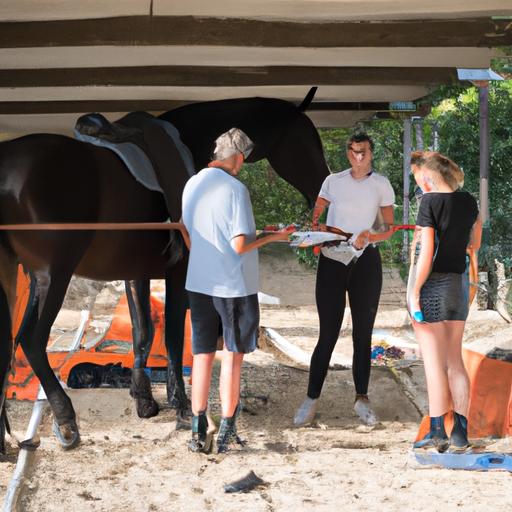Revolutionize the horse training industry with a horse training union. Discover the benefits, formation process, and success stories in this game-changing movement.
Introduction

Are you passionate about horse training? Do you believe in fair wages, professional development, and the welfare of these majestic creatures? If so, then you’re about to embark on a journey that could transform the horse training industry forever. Welcome to the world of the Horse Training Union.
Overview of Horse Training Practices
Before we delve into the significance of a horse training union, let’s take a moment to understand the landscape of this industry. Horse training is an intricate art that requires expertise, dedication, and a deep understanding of equine behavior. Trainers invest countless hours honing their skills to ensure the horses under their care reach their full potential.
Importance of a Horse Training Union in the Industry
Picture this: a united community of horse trainers, advocating for their rights, demanding fair compensation, and working towards the betterment of the industry as a whole. That’s precisely what a horse training union aims to achieve. By forming a collective voice, trainers can address common challenges, negotiate better working conditions, and elevate the standards of horse training.
Introducing the Concept of the Horse Training Union
You might be wondering, what exactly is a horse training union? Well, it’s a formal organization that represents the interests of horse trainers. Just like any other union, it strives to protect the rights of its members, enhance their professional growth, and facilitate a safe and ethical working environment. Through collaboration and unity, the horse training union aims to bring about positive change in an industry that has long been in need of reform.
As we explore the benefits, formation process, and success stories of existing horse training unions in the subsequent sections, you’ll gain a deeper understanding of how this movement can transform the lives of trainers and the horses they work with. Join me on this captivating journey, as we uncover the potential of the horse training union and unlock a brighter future for the equine industry.
Stay tuned for Section 2, where we’ll dive into the incredible benefits of a horse training union. Are you ready to revolutionize the industry? Let’s gallop ahead together!
Benefits of a Horse Training Union

Are you ready to uncover the remarkable benefits that a horse training union brings to the table? Let’s gallop right into it!
A. Ensuring Fair Wages and Working Conditions for Trainers
One of the primary advantages of a horse training union is its ability to secure fair wages and improved working conditions for trainers. By negotiating collectively with employers, the union can establish minimum salary standards, overtime regulations, and other provisions that protect the financial well-being of trainers. No longer will talented trainers be undervalued or subjected to exploitative practices. It’s time to level the playing field and ensure that their hard work is duly recognized.
B. Providing a Platform for Professional Development and Training
In the ever-evolving world of horse training, continuous learning and growth are essential. A horse training union serves as a valuable platform for trainers to enhance their skills and knowledge. Through workshops, seminars, and certification programs, trainers can stay updated with the latest training techniques, equine research, and industry trends. This not only benefits individual trainers but also elevates the overall standard of horse training, ensuring that horses receive the highest quality care and training.
C. Promoting Safety Standards and Guidelines in Horse Training
The safety of both trainers and horses should always be a top priority. A horse training union plays a crucial role in establishing and promoting safety standards and guidelines. From implementing proper equipment usage protocols to enforcing safe training practices, the union ensures that trainers have a secure and healthy working environment. By prioritizing safety, trainers can focus on their craft without unnecessary risks, resulting in happier and healthier horses.
D. Advocating for the Rights and Welfare of Horses
Horses are not just athletes; they are sentient beings deserving of love, care, and respect. A horse training union acts as a powerful advocate for the rights and welfare of these magnificent creatures. By speaking out against animal cruelty, ensuring proper treatment, and promoting ethical training methods, the union ensures that horses receive the respect and care they deserve. Together, trainers can create a compassionate and sustainable future for the equine industry.
Stay tuned for Section 3, where we’ll uncover the process of forming a horse training union and the importance of collaboration among trainers. Are you ready to gallop towards change? Let’s continue this inspiring journey together!
Formation of a Horse Training Union

A. Steps involved in establishing a horse training union
Creating a horse training union requires careful planning and strategic execution. Here are the essential steps to follow when establishing a union for trainers:
-
Research and Education: Begin by conducting thorough research on existing horse training unions and their structures. Educate yourself on the legal aspects, membership requirements, and potential benefits of forming a union.
-
Identify Goals and Objectives: Define the specific goals and objectives you wish to achieve through the union. This could include fair wages, improved working conditions, access to training resources, or collective bargaining power.
-
Build a Supportive Network: Reach out to fellow trainers who share your vision and passion. Forming a supportive network is crucial for garnering support and building momentum for the unionization process.
-
Elect a Leadership Team: Establish a leadership team that will guide the formation of the union. This team should consist of dedicated individuals who can effectively communicate, organize, and advocate for the interests of trainers.
-
Membership Drive: Begin recruiting trainers to join the union. Promote the benefits and advantages of union membership, emphasizing the collective strength it provides for addressing common challenges.
-
Develop Bylaws and Constitution: Work with your leadership team to draft bylaws and a constitution for the union. These documents will outline the rights, responsibilities, and governance structure of the union.
B. Importance of collaboration and unity among trainers
Collaboration and unity are the cornerstones of a successful horse training union. By coming together as a cohesive entity, trainers can amplify their voices and effect meaningful change. Here’s why collaboration is vital:
-
Strength in Numbers: When trainers unite, they possess greater leverage to negotiate fair wages, improved working conditions, and other benefits. The collective power of a union can sway industry practices and ensure trainers’ needs are met.
-
Sharing Knowledge and Resources: Collaborating within a union allows trainers to share their expertise, techniques, and training resources. This leads to professional growth and encourages the development of best practices within the industry.
-
Support System: A horse training union provides a support system for trainers, fostering a sense of camaraderie and solidarity. Trainers can seek advice, share experiences, and find reassurance in knowing they are not alone in their challenges.
C. Legal considerations for forming a union in the horse training industry
Before embarking on the journey of forming a horse training union, it’s crucial to understand the legal considerations involved. Here are some key points to consider:
-
Research Labor Laws: Familiarize yourself with labor laws specific to the horse training industry in your region. Understand the legal framework surrounding unions, collective bargaining, and workers’ rights.
-
Consult Legal Experts: Seek guidance from legal professionals specializing in labor law. They can provide valuable advice on navigating legal requirements, ensuring compliance, and protecting the rights of trainers.
-
Establish Union Structure: Determine the most suitable union structure based on legal considerations. This may involve registering as a nonprofit organization, obtaining necessary permits, and adhering to reporting obligations.
By being well-informed and following legal protocols, trainers can lay a solid foundation for their horse training union, paving the way for a united and impactful movement. Stay tuned for Section 4, where we’ll explore the challenges and obstacles that may arise during the unionization process. Together, we’ll overcome them and gallop towards a brighter future for horse trainers.
Challenges and Obstacles
The path towards establishing a horse training union is not without its hurdles. In this section, we will explore the challenges that trainers may face when advocating for their rights and the welfare of the equine industry.
Resistance from Certain Stakeholders in the Industry
When a movement emerges to challenge the status quo, it is not uncommon to encounter resistance from those who benefit from the existing system. In the case of a horse training union, there may be individuals or organizations within the industry who are resistant to change. These stakeholders may fear a loss of control or perceive the union as a threat to their interests. Overcoming this resistance requires open dialogue, education, and a willingness to find common ground for the betterment of all involved parties.
Overcoming Misconceptions and Myths about Unions
Unions have often been the subject of misconceptions and myths that can hinder their progress. Some may believe that unions only create conflict or that they are unnecessary in industries such as horse training. It is crucial to address these misconceptions head-on and educate trainers and industry stakeholders about the benefits that a horse training union can bring. By dispelling these myths, we can pave the way for a more informed and supportive community.
Securing Membership and Participation from Trainers
One of the key challenges of forming a horse training union is garnering membership and participation from trainers. Some trainers may be hesitant to join due to concerns about potential repercussions or a lack of understanding about the union’s objectives. Building trust, providing transparent information, and demonstrating the tangible benefits of union membership are essential in addressing these concerns and encouraging trainers to actively participate in the movement.
By acknowledging and addressing these challenges, the horse training union can navigate the path towards success. In the next section, we will explore inspiring success stories from existing horse training unions, shedding light on the positive impact they have had on trainers and the equine industry as a whole.
Stay tuned for Section 5, where we’ll dive into the success stories of horse training unions around the world. Let’s overcome these challenges together and pave the way for a brighter future for horse trainers and their noble companions!
Success Stories of Existing Horse Training Unions
Highlighting Successful Horse Training Unions Around the World
The impact of horse training unions is not limited to a specific region; they have spread their influence across the globe. Let’s explore some remarkable success stories that showcase the power of collective action in the equine industry.
One shining example is the United Horse Trainers Association (UHTA) in the United States. With a diverse membership comprising trainers from various disciplines, the UHTA has successfully advocated for fair wages, improved working conditions, and better access to professional development opportunities. Their unwavering commitment to the welfare of both trainers and horses has earned them immense respect within the industry.
Examining the Positive Impact of These Unions on Trainers and Horses
Horse training unions have proven to be game-changers, positively influencing the lives of trainers and the horses they work with. By providing a united front, these unions have been instrumental in improving the overall wellbeing of trainers, ensuring they receive fair compensation and equitable treatment. This, in turn, fosters a more motivated and dedicated workforce that can provide superior care and training to the horses entrusted to their care.
Furthermore, horse training unions have been at the forefront of promoting ethical practices and safety standards. By establishing guidelines and protocols, they strive to eliminate abusive training methods, prioritize the physical and mental health of horses, and create a harmonious environment for both trainers and equines.
Sharing Examples of Improved Working Conditions and Benefits for Trainers
The success stories of horse training unions go beyond rhetoric; they have tangible outcomes that directly impact trainers’ lives. For instance, the Australian Horse Trainers’ Union (AHTU) has secured significant improvements in working conditions by negotiating for reasonable hours, adequate breaks, and safe training facilities. Additionally, trainers affiliated with the AHTU have access to comprehensive health insurance, retirement plans, and ongoing professional development opportunities.
Similarly, the European Union of Equestrian Trainers (EUET) has been instrumental in ensuring fair pay for trainers across Europe. Through collective bargaining, they have managed to establish minimum wage standards and implement transparent payment structures, providing trainers with financial security and stability.
These success stories exemplify the transformative power of horse training unions. By joining forces, trainers can create a more equitable and rewarding environment that benefits both themselves and the horses they dedicate their lives to. In the following section, we will explore the process of forming a horse training union, empowering you to take the reins and drive change within the industry.


